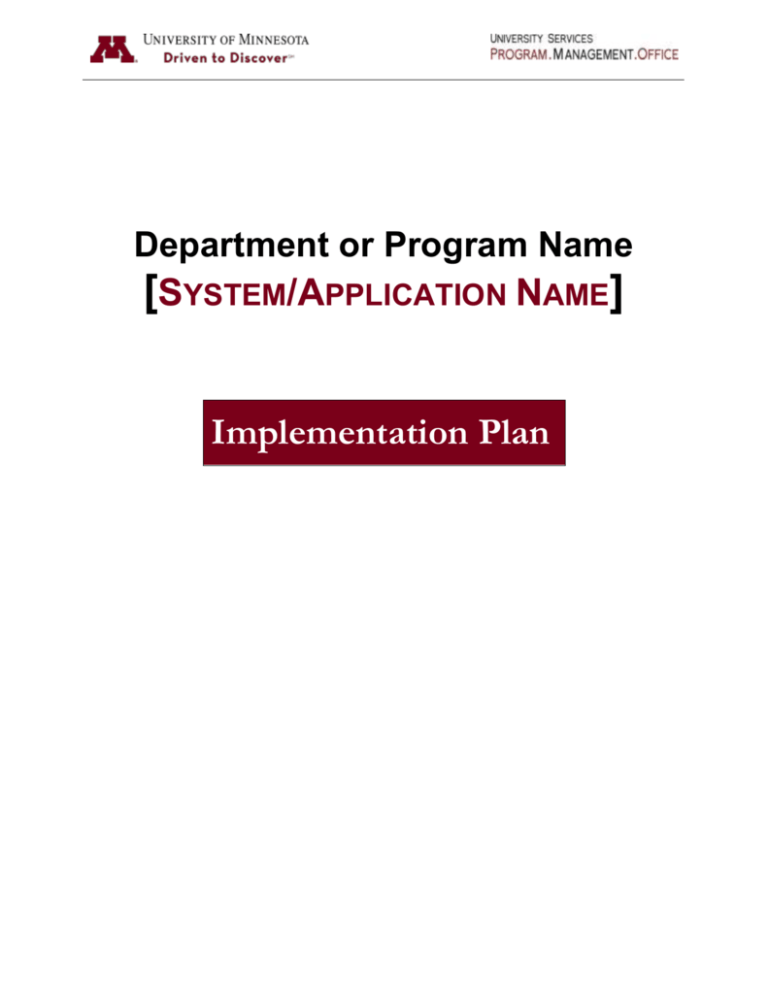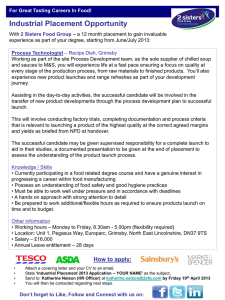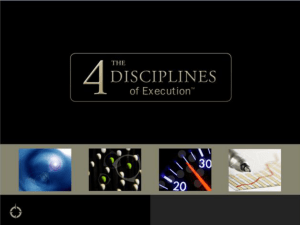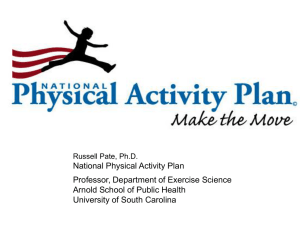
Department or Program Name
[SYSTEM/APPLICATION NAME]
Implementation Plan
SYSTEM/APPLICATION NAME
IMPLEMENTATION PLAN
Project Implementation Plan
Template Guidelines
To aid in the completion of a Project Implementation Plan please adhere to the following guidelines. For
specific information regarding project deliverables, please refer to the University Services Program
Management Office. Remove these guidelines from the completed document.
Purpose
The Project Implementation Plan describes the strategy involved in preparing the end
users and the target product, service, or system into daily use or production. This can
include introducing a new product into the marketplace for customer consumption,
installing and propagating a new technology, or carrying out a new process/business
line. The objective of producing an Implementation Plan is to reduce risk of
implementation failure by planning the impact to the business when the product,
service, or system is implemented. Its intent is to have a centralized reference
document that organizes all of the information needed for implementation (i.e.,
identifies all the tasks that must be completed and the responsible parties that must be
involved to implement the project successfully).
The Project Implementation Plan is a master plan that summarizes all of the individual
plans to be performed to implement the project. These plans may be documented as
part of the implementation plan or as separate project plans, depending on the type,
complexity, and size of the project.
Ownership
The Project Manager is responsible for completion of the Implementation Plan, with
input from project leads and the Project Customer as necessary.
When
Phase: Execute
SDLC: Develop
The Implementation Plan is completed during the Design (planning of the document)
and Develop (physically create the document) Phases of Solution Delivery Life Cycle.
Template
Completion
Note: Text
within < >
brackets needs
to be replaced
with projectspecific
information.
It is a required deliverable on all Medium and Large projects, and a best practice for
Small projects.
1. Do not include the Template Guidelines in your final document. Enter the project
information in the page header and footer, title page, and document contributors
and version control.
2. Complete the document utilizing suggested text where applicable and entering
text/fields where shown within <blue text> brackets. Note that the blue text is
NOT to be included in your final document. Its purpose is to either provide
guidance for completing the document, or to show where text/fields are to be
input.
3. Once changes are made to your document and you’re ready to finalize, ensure
that you update your Table of Contents (TOC) section. To Update the TOC: If
you are unsure how to do this, place your mouse arrow to the left of the first entry
in the Table of Contents section and click the left button once. Once the entire
section is highlighted, move the mouse arrow anywhere within the highlighted
section and click the right button once. In the drop-down menu, choose Update
Field and Page Numbers Only or Entire Field as needed. Note that you might
need to repeat the aforementioned steps to change the font back to Tahoma 10
pt.
4. If changes are to be made, update the Revision History information accordingly.
5. The Implementation Plan is to be retained with other project-related
documentation and maintained in accordance with the business line’s records
retention policy.
SYSTEM/APPLICATION NAME
Empowerment
& Scalability
Important
Notice
IMPLEMENTATION PLAN
This template is provided as a guideline to follow in producing the minimum basic
information needed to successfully complete a Project Implementation Plan in meeting
EPM guidelines and illustrates the art and science of project management. Project
Managers are empowered to use this template as needed to address any specific
requirements of the proposed project at hand. The amount of detail included in the
template will depend on the size and complexity of the project. Depending on project
or business line needs, categories can be added, but cannot be deleted. If a category
does not apply, do not delete it, but rather mark it as “Non-applicable” and provide a
brief explanation as to why it does not apply to the project.
As this template may change, it is highly recommended that you access a blank
template from the WFS Program Office Website each time you need one for a new
project and not merely use one from a previous project by changing the old text.
SYSTEM/APPLICATION NAME
IMPLEMENTATION PLAN
DOCUMENT INFORMATION AND APPROVALS
VERSION HISTORY
Version #
Date
Revised By
Reason for change
1.0
9/17/09
Aaron Demenge
PMO Review
DOCUMENT APPROVALS
Approver Name
Project Role
Signature/Electronic Approval
Date
SYSTEM/APPLICATION NAME
IMPLEMENTATION PLAN
TABLE OF CONTENTS
Overview ......................................................................................................................... 1
Background ............................................................................................................................................... 1
Overall Approach ....................................................................................................................................... 1
Organizational Perspective ....................................................................................................................... 1
Involved User Groups ................................................................................................................................ 1
Implementation Communications ................................................................................ 1
Management ............................................................................................................................................. 1
User/Customer Support............................................................................................................................. 1
Operations ................................................................................................................................................. 1
Technical ................................................................................................................................................... 1
Organizational Change Plan ......................................................................................... 1
Preparation ................................................................................................................................................ 1
Execution ................................................................................................................................................... 2
Follow-up ................................................................................................................................................... 2
Staff Planning................................................................................................................. 2
Operations ................................................................................................................................................. 2
Technical ................................................................................................................................................... 2
Interdepartmental Roles and SLA’s (Service Level Agreements) Planning ............. 2
Accounting and Billing .................................................................................................. 2
Policy Management ....................................................................................................... 2
Implementation/Release Schedule ............................................................................... 3
User Readiness Plan ..................................................................................................... 3
Management ............................................................................................................................................. 3
User/Customer Support............................................................................................................................. 3
Operations ................................................................................................................................................. 3
Technical ................................................................................................................................................... 3
Data Migration/Conversion Plan................................................................................... 4
Preparation ................................................................................................................................................ 4
Actual Conversion ..................................................................................................................................... 4
Conversion Verification (Clean-up) ........................................................................................................... 4
Installation Plan ............................................................................................................. 4
Preparation ................................................................................................................................................ 4
Execution ................................................................................................................................................... 4
Clean-up Steps .......................................................................................................................................... 4
Go/No Go Decision ................................................................................................................................... 4
Product Stabilization/Warranty Period ...................................................................................................... 4
Transition to Production Support ............................................................................................................... 5
Lessons Learned ....................................................................................................................................... 6
Signoff/acknowledgement ............................................................................................ 6
Appendix 1 - Proposed Production support model .................................................... 7
Appendix 2 – Implementation readiness assessment ................................................ 8
SYSTEM/APPLICATION NAME
IMPLEMENTATION PLAN
OVERVIEW
Background
Provide a system overview, any requirements to use the system, required locations, and method
to implementing the proposed project solution. This section is intended to be completed at a very
high level. It may be as long as necessary, but most information should be contained in a half of
a page. This section is intended to provide the background information necessary to place the
individual plans that follow into perspective.
Overall Approach
Include the underlying rationale for using the approach described above and describe the overall
schedule for implementing the plan.
Organizational Perspective
Describe all the modifications that will be necessary in the organizational structure, work flow, and
personnel plans in order to support the new product, service, or system.
Involved User Groups
Describe all the stakeholders, users or other parties impacted by the delivery of this solution.
IMPLEMENTATION COMMUNICATIONS
Management
Identify the audience who will receive the management communications and describe the type of
communications medium to be used and the purpose for the communications message.
User/Customer Support
Identify the audience who will receive the user/customer support communications and describe
the type of communications medium to be used and the purpose for the communications
message.
Operations
Identify the audience who will receive the operations communications and describe the type of
communications medium to be used and the purpose for the communications message.
Technical
Identify the audience who will receive the technical communications and describe the type of
communications medium to be used and the purpose for the communications message.
ORGANIZATIONAL CHANGE PLAN
Preparation
List all the steps that are needed to prepare for the organizational change. (The necessary
organizational change was to be described earlier in the overview section.) For each step,
describe the actions to be taken, all individuals or groups affected by the step, the individual(s) or
group(s) responsible for executing the step, and the start and end date for the step. List steps in
a logical sequence of events.
© 2012 Regents of the University of Minnesota. All rights reserved. Revised February 6, 2016
Page 1
SYSTEM/APPLICATION NAME
IMPLEMENTATION PLAN
Execution
List all the steps that are needed to actually move the organization from its current state to the
new state. For each step, describe the actions to be taken, all individuals or groups affected by
the step, the individual(s) or group(s) responsible for executing the step, and the start and end
date for the step. List steps in a logical sequence of events.
Follow-up
List all the steps that are needed to follow-up the organizational change to determine the success
of the change, address any problems, concerns or issues arising from the change, and to ensure
the organization has not reverted to its prior state. For each step, describe the actions to be
taken, all individuals or groups affected by the step, the individual(s) or group(s) responsible for
executing the step, and the start and end date for the step. List steps in a logical sequence of
events.
STAFF PLANNING
Operations
List the number, job description, and roles and responsibilities of business personnel needed - by
location - during actual implementation and the ongoing operations of the new system in order to
recover the business benefit described by the project.
Technical
List the number, job description, and roles and responsibilities of business personnel needed - by
location - during actual implementation of the new system and the subsequent postimplementation production support.
INTERDEPARTMENTAL ROLES AND SLA’S (SERVICE LEVEL AGREEMENTS)
PLANNING
List the key contacts by department and expected escalation and response SLAs required. If
separate SLA document(s) are not to be prepared (i.e. falls within existing master SLA
documents, include key information in this section and Appendix 1; otherwise refer to the new
SLA document.
ACCOUNTING AND BILLING
Describe any changes to Accounting and Billing required to implement the proposed solution, if
applicable.
POLICY MANAGEMENT
List the changes to existing policy or procedures required to implement the proposed solution, if
applicable.
© 2012 Regents of the University of Minnesota. All rights reserved. Revised February 6, 2016
Page 2
SYSTEM/APPLICATION NAME
IMPLEMENTATION PLAN
IMPLEMENTATION/RELEASE SCHEDULE
Prepare a detailed implementation schedule. Include all of the sub-plans contained within the
Implementation Plan (training, documentation, organizational change, and installation). For each
activity listed on the schedule, include assigned personnel resources, start date, end date, and
the estimated duration of the activity.
USER READINESS PLAN
Management
Identify the audience who will receive the management training and describe the purpose for the
training. Identify all of the individual courses that will be prepared and presented for this training.
For each identified course, include: (a) the course name, (b) the type of training (classroom,
CBT, etc.), (c) the course content, and (d) the estimated duration. Identify all of the supporting
materials that will be required for the training, such as: training manuals; teachers guides;
overheads; etc. Prepare a tentative schedule and indicate what courses will be offered when and
who from the management audience will attend each course offering.
User/Customer Support
Identify the audience who will receive the user/customer support training and describe the
purpose for the training. Identify all of the individual courses that will be prepared and presented
for this training. For each identified course, include: (a) the course name, (b) the type of training
(classroom, CBT, etc.), (c) the course content, and (d) the estimated duration. Identify all of the
supporting materials that will be required for the training, such as: training manuals; teacher’s
guides; overheads; etc. Prepare a tentative schedule and indicate what courses will be offered
when and who from the user/customer support audience will attend each course offering.
Operations
Identify the audience who will receive the operations training and describe the purpose for the
training. Identify all of the individual courses that will be prepared and presented for this training.
For each identified course, include: (a) the course name, (b) the type of training (classroom,
CBT, etc.), (c) the course content, and (d) the estimated duration. Identify all of the supporting
materials that will be required for the training, such as: training manuals; teacher’s guides;
overheads; etc. Prepare a tentative schedule and indicate what courses will be offered when and
who from the operations audience will attend each course offering.
Technical
Identify the audience who will receive the technical training and describe the purpose for the
training. Identify all of the individual courses that will be prepared and presented for this training.
For each identified course, include: (a) the course name, (b) the type of training (classroom,
CBT, etc.), (c) the course content, and (d) the estimated duration. Identify all of the supporting
materials that will be required for the training, such as: training manuals; teacher’s guides;
overheads; etc. Prepare a tentative schedule and indicate what courses will be offered when and
who from the technical audience will attend each course offering.
© 2012 Regents of the University of Minnesota. All rights reserved. Revised February 6, 2016
Page 3
SYSTEM/APPLICATION NAME
IMPLEMENTATION PLAN
DATA MIGRATION/CONVERSION PLAN
Preparation
Refer to any business requirement definition document(s) and any architectural or design
document(s), or meet with the conversion team for the project to provide input for this section.
Actual Conversion
Conversion info goes here…
Conversion Verification (Clean-up)
Conversion info goes here…
INSTALLATION PLAN
Preparation
List all hardware, software, equipment, environmental, supply, and other application systems
requirements needed for installation of the new system as applicable. Include both existing and
new hardware, software or equipment, and identify which is which. For environmental, include
such items as construction of special rooms, installation of cooling systems, electrical rewiring,
etc.
Execution
Describe the kind of testing that will take place in interim operations. List the activities to be
performed for the actual system installation. List the activities to be performed to verify the
system installation is correct. List the contingency activities to be performed if the installation
should fail. Describe the procedure to be used to resolve problems encountered during
installation.
Security
Application
Fall back plan to (to re-enable the legacy system in the event of catastrophic failure)
Clean-up Steps
Describe the steps to be followed to turn off the old system, obtain feedback on the
implementation process, and measure initial use of the new system.
Go/No Go Decision
Describe the process to engage stakeholders in a process to commit to product/service release.
This should be added with the Launch Readiness Assessments (appendix 2).
Product Stabilization/Warranty Period
The stabilization period is a scheduled one-week period in which resources will be dedicated to
monitor, identify, troubleshoot, and respond to known issues affecting the ability to request,
process, print, and manage Security ID badges.
Product stabilization will be managed by the departmental IT Manager who will own the
product/system after transition to production support, but will rely on the following contacts to
assist:
© 2012 Regents of the University of Minnesota. All rights reserved. Revised February 6, 2016
Page 4
SYSTEM/APPLICATION NAME
IMPLEMENTATION PLAN
Process Owner
Role/Representation
Project Manager
Project Technical Lead
Contact
Transition to Production Support
Describe the steps to be followed for final knowledge transfer and transition to production
support.
Transition Planning Schedule:
Activity
Review Implementation
Readiness Assessment
Review Business Continuity
Planning
Review and transition
Technical Support
Review Testing Transition
Review Training Transition
Review Document Archiving
Key Deliverable
Implementation Readiness
Assessment (Appendix 2)
Implementation Plan
Technical Design
Specification and
Implementation Plan
Test Plan and Test Scripts
User guides, quick
reference material and
training outlines
Project SharePoint
website
Role/Representation
PM with Business and
Technical Team
PM and Business
Sponsor
PM and Technical
Lead/Production
Support Team
PM and PMO QA
Lead
PM and PMO
Technical Trainer
Date
PM and PMO PM
After the product stabilization period, the department will formally acknowledge client acceptance
of the application and the system transitions to production support mode. The Project moves to
Project Close-out and is no longer involved in the ongoing administration of the project or system.
Ownership of the technical support of agreed up modifications, changes, enhancements, or fixes
falls to the departmental technical manager and as defined in the Service Level Agreement
(SLA). The technical manager also works with others as defined in the Product Management
Hierarchy Diagram (below) and the Production Support Model (appendix 1).
Product Management Hierarchy Diagram:
© 2012 Regents of the University of Minnesota. All rights reserved. Revised February 6, 2016
Page 5
SYSTEM/APPLICATION NAME
IMPLEMENTATION PLAN
Customer
1
Customer
2
Process
Owner
Helpdesk/
Service Center
Technical
Manager
Customer
3
Infrastructure
SE
DBA
Interface
1
Interface
2
Interface
3
Interface
4
Role
Lessons Learned
Describe how lessons learned from the project will be gathered, documented, and made available
as a learning experience for each new departmental implementation.
Refer to the standard templates for lessons learned surveys and summary documents.
The PMO can facilitate any lessons learned surveying, meeting facilitation and summary
documentation.
SIGNOFF/ACKNOWLEDGEMENT
I agree that the [Project Name] Implementation Plan is complete as is known today, accurately
reflect the strategic and operational direction of [Department Sponsor] regarding the project, and
when delivered fulfill the business needs of my department within the broader project goals as
defined by the project Business Case and Charter.
I understand that by agreeing to the Project Implementation Plan, I approve of the activities
defined and authorize my department to participate as documented for the successful
implementation of the [project solution] in our department.
________________________
Name
Title
Date: ___/___/___
________________________
Name
Title
Date: ___/___/___
________________________
Name
Title
Date: ___/___/___
© 2012 Regents of the University of Minnesota. All rights reserved. Revised February 6, 2016
Page 6
SYSTEM/APPLICATION NAME
IMPLEMENTATION PLAN
APPENDIX 1 - PROPOSED PRODUCTION SUPPORT MODEL
Production Support Model for [Project Name]
Call for Support
User
(Customer)
Initiate Call
Provide Support
Escalate
Follow up
Resolve
Close Ticket
Update FAQs
Maintain/Modify
Legend:
User
confirms
resolution
Calls support
Helpdesk (DCS
Service Request)
Confirm Close
Log ticket
Provides
resolution
Escalate per
SLA
[Support Structure]
[Support Structure]
[Support Structure]
[Support Structure]
[Support Strucure]
[Support Structure]
Required
process
Follow up on
open tickets
Update open
ticket
Resolve
Issue
Responds to
follow up
Provide
update
Update
FAQs
Resolve
Issue
Responds to
follow up
Provide
update
Update
FAQs
Resolve
Issue
Responds to
follow up
Provide
update
Update
FAQs
Resolve
Issue
Responds to
follow up
Provide
update
Update
FAQs
Resolve
Issue
Responds to
follow up
Provide
update
Update
FAQs
Resolve
Issue
Responds to
follow up
Provide
update
Update
FAQs
Ticket Closed
Update
FAQs
Optional
process
Process flow
Notes:
[Support Structure]
Inputs
- Support access
number
- SLA
- Call for support
- User description
- Product docs
- FAQs
- Escalation path
- Unresolved
service/support
call
- Escalated
service/support
call
- Unresolved
ticket in Service
Center
- Repeat call
- Resolved ticket
in Service
Manager
- Confirmation
from customer
issue is resolved
- Helpdesk ticket
and resolution
- Call frequency
- Connection to
production
support
- Logged support
call
- Call/ticket #
- Support initiated
- Transfer to next
level support
- Resolved call
- Additional
research
- Updated
Service Center
ticket log
- SLA report
- Updated FAQ to
increase chances
of first call
resolution
- Initial training
- Quick reference
- Web help
- Service Center
- Initial training
- Quick reference
- Web help
- Initial training
- Quick reference
- Escalation path
- Initial training
- Quick reference
- Web help
- Product docs
- Updated
Service Center
ticket log
- New escalation
- SLA report
- Service Center
reports
- Updated
Service Center
ticket log
- SLA report
Tools/Process
- Resolved call
- Updated
Service Center
ticket
- Call escalation
- Initial training
- Quick reference
- FAQs
- Escalation path
- Service
Manager
- Service
Manager
- Service Center
- Incident
Management
- UITT Request
- Test Director
Risk/Issues
- User knows
single support
number
- User knows
single support
number
- Must establish
SLA to escalate
- Helpdesk knows
escalation
channels and
process
- Issue must be
researched
- App/Db patch/
fix/update
- Open calls are
routinely
monitored
- None
- None
- All support
users know
Service Manager
- Java
development
support
Outputs
© 2012 Regents of the University of Minnesota. All rights reserved. Revised February 6, 2016
Page 7
- DCS Program /
DCS IT
Enhancement
Request
- Assigned BA
- Requirements
- Design
- Assigned TD
- Release sched.
[Author]
[Date]
[Version]
SYSTEM/APPLICATION NAME
IMPLEMENTATION PLAN
APPENDIX 2 – IMPLEMENTATION READINESS ASSESSMENT
30 Days Prior to Launch
Project Manager’s summary of the readiness to launch today.
Score (1 to 5 with 5 being completely ready) ____
Thoughtful commentary:
Summary (score and commentary) of the readiness of:
The application as determined by the Tech lead or software architect
Score (1 to 5 with 5 being completely ready) ____
Thoughtful commentary:
The application as determined by the BA lead
Score (1 to 5 with 5 being completely ready) ____
Thoughtful commentary:
The application as determined by the QA lead
Score (1 to 5 with 5 being completely ready) ____
Thoughtful commentary:
Business Partner assessment.
Score (1 to 5 with 5 being completely ready) ____
Thoughtful commentary:
The launch materials as determined by the Business lead
Score (1 to 5 with 5 being completely ready) ____
Thoughtful commentary:
The operational/user readiness as determined by the Business lead
Score (1 to 5 with 5 being completely ready) ____
Thoughtful commentary:
List and describe the most significant obstacles to launch. Assess each obstacle for impact and
likelihood. Where the impacts are high, what mitigation (e.g. agreed on “plan b”) might be in the works?
Obstacle to Launch
Reason /
Background
Impact / Risk
Mitigation
List any features that are candidates for not being included with the initial launch. Describe the effect of
the absence.
Feature at Risk
Why, how hard to supply
Impact of launching without
© 2012 Regents of the University of Minnesota. All rights reserved. Revised February 6, 2016
Page 8
SYSTEM/APPLICATION NAME
IMPLEMENTATION PLAN
10 Days Prior to Launch
Update the 30 day assessment above with status of things identified and any new information / concerns /
risks on top.
Project Manager’s summary of the readiness to launch on schedule:
Score (1 to 5 with 5 being completely ready) ____
Thoughtful commentary:
Project Manager’s summary of the readiness to launch today:
Score (1 to 5 with 5 being completely ready) ____
Thoughtful commentary:
Project Manager’s recommendations for launch.
__ Complete, unaltered launch on schedule
__ On schedule launch but with conditions (e.g. certain features absent)
__ Delay (If the determination is to delay the launch be sure that is decided now so communication can
begin ASAP. A no-go decision needs to be communicated in person to the stakeholders. )
Business Partner’s summary of the readiness to launch on schedule:
Score (1 to 5 with 5 being completely ready) ____
Thoughtful commentary:
Business Partner’s summary of the readiness to launch today:
Score (1 to 5 with 5 being completely ready) ____
Thoughtful commentary:
Business Partner’s recommendations for launch.
__ Complete, unaltered launch on schedule
__ On schedule launch but with conditions (e.g. certain features absent)
__ Delay (If the determination is to delay the launch be sure that is decided now so communication can
begin ASAP. A no go decision needs to be communicated in person to the stakeholders. )
Just Prior to Launch Assessment
Update the 10 day assessment above with status of things identified and any new information / concerns /
risks on top.
Has the PM signed off? __
Has QA Lead signed off? __
Has BA Lead signed off? __
© 2012 Regents of the University of Minnesota. All rights reserved. Revised February 6, 2016
Page 9
SYSTEM/APPLICATION NAME
IMPLEMENTATION PLAN
Has the Tech Lead signed off? __
Has the Business Partner(s) accepted the product/application and the terms of the launch? The
risks and absent features are documented and s/he has approved? ___
If there is significant concern, involve the Program Management Office!
© 2012 Regents of the University of Minnesota. All rights reserved. Revised February 6, 2016
Page 10







